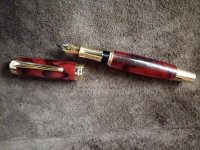-
Thanks for visiting The Penturners Forum today.
There are many features and resources that currently you are unable to see or access, either because you're not yet registered, or if you're already registered, because you're not logged in.
To gain full access to the forum, please log in or register now. Registration is completely free, it only takes a few seconds, and you can join our well established community of like-minded pen makers.
You are using an out of date browser. It may not display this or other websites correctly.
You should upgrade or use an alternative browser.
You should upgrade or use an alternative browser.
First acrylic fountain pen
angelo49
Registered
Good looking pen Margo!!



alpha1
Fellow
Well done a nice pen.
wm460
Grand Master
- Joined
- Mar 16, 2013
- Posts
- 23,113
- First Name
- Mark
Well done great looking Pen Margo.



Leatherlass
Full Member
Lovely pen Margo, the blank goes well with the gold fittings 

Penpal
Grand Master
Neat pen Margo.
Peter.
Peter.
That's a great match with the pen. How are you finishing your acrylic Margo?
Hi Phil,
I use micromesh, then a couple of coats of CA glue (this went wrong on one part and had to be taken off again!)
Then a wipe or two of burnishing cream.
I have been advised that burnishing cream is better than tcut car polish, which I did previously! It is, though I'm not sure if I'm doing it right... Wipe it on, turn the lathe on slowish and polish, using an old tack cloth.
I use micromesh, then a couple of coats of CA glue (this went wrong on one part and had to be taken off again!)
Then a wipe or two of burnishing cream.
I have been advised that burnishing cream is better than tcut car polish, which I did previously! It is, though I'm not sure if I'm doing it right... Wipe it on, turn the lathe on slowish and polish, using an old tack cloth.
You don't need to bother with the CA Margo. Get a good finish with abrasives, so that you don't have any tooling marks or radial marks showing. I always give it a good going over with 0000 wire wool too (along the length, with the lathe stopped), as a last abrasive process. Then you can get to work with the burnishing cream.
Yes, Tcut is quite coarse - burnishing cream is much finer, but by putting on CA, you are introducing a medium which firstly, unless you de-nib it and go though a fine abrasive routine again, will cause imperfections over the top of an already perfect surface, secondly is un-necessary since the surface doesn't need sealing, thirdly, will only sit on the surface rather than integrate with it as it might with wood, and therefore may well flake or chip in time, and fourthly, won't shine any more than by omitting it and just using burnishing cream.
Use a clean tissue to wipe off the cream though, in preference to a tack cloth. Rather than just wiping it on, work it in, and work at it with the lathe running like you would an abrasive, which is what it in fact is. Take it off with the clean tissue, and keep turning it to a clean part until all the blackening is removed. There's no harm in repeating the process as many times as you need to. You need to burnish at a sort of medium speed. There are those that do everything at the fastest possible speed, but you'll get a better, more even shine if you slow it down to maybe 1500 - 1800rpm. Fastest isn't always best, and certainly slow is no good for burnishing.
I hope that helps
Yes, Tcut is quite coarse - burnishing cream is much finer, but by putting on CA, you are introducing a medium which firstly, unless you de-nib it and go though a fine abrasive routine again, will cause imperfections over the top of an already perfect surface, secondly is un-necessary since the surface doesn't need sealing, thirdly, will only sit on the surface rather than integrate with it as it might with wood, and therefore may well flake or chip in time, and fourthly, won't shine any more than by omitting it and just using burnishing cream.
Use a clean tissue to wipe off the cream though, in preference to a tack cloth. Rather than just wiping it on, work it in, and work at it with the lathe running like you would an abrasive, which is what it in fact is. Take it off with the clean tissue, and keep turning it to a clean part until all the blackening is removed. There's no harm in repeating the process as many times as you need to. You need to burnish at a sort of medium speed. There are those that do everything at the fastest possible speed, but you'll get a better, more even shine if you slow it down to maybe 1500 - 1800rpm. Fastest isn't always best, and certainly slow is no good for burnishing.
I hope that helps
geordie0928
Graduate Member
Nice pen mate.






I agree with Phil. I sand at 900-1000 rpm & burnish at 1500-1600 tpm. Any faster & the speed throws the polish off as fact as you try to apply it. Like Phil my last abrasive is 0000 wire wool.
A lovely pen by the way. Well done.
A lovely pen by the way. Well done.

Mark James
Full Member
Wonderful work. Phil's post above - #10 is superb!



